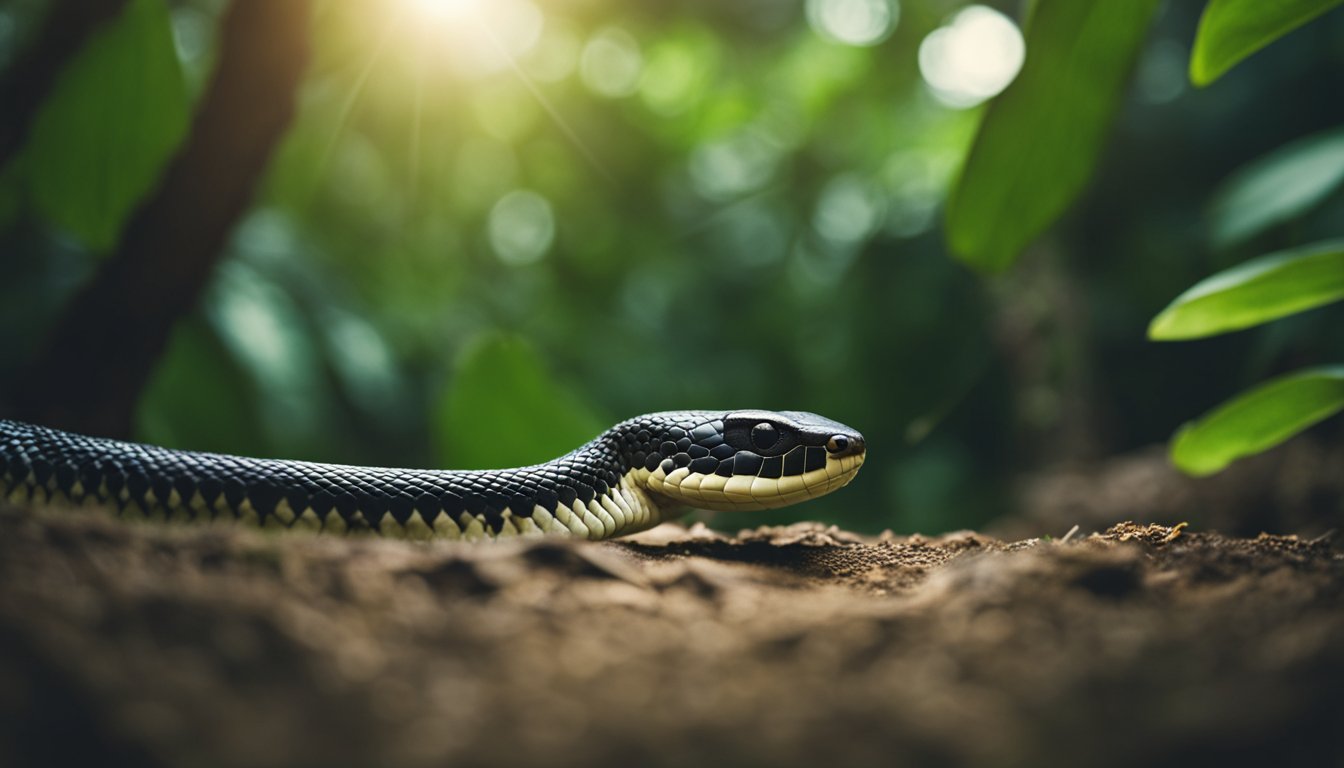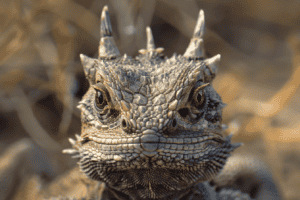Imagine wandering through a lush green forest when you suddenly spot a snake. Your heart might skip a beat, especially if you think it could be venomous!
But have you ever wondered why some snakes come equipped with a venomous bite? Well, it’s a fascinating tale of evolution and survival.
Venomous snakes, like the king cobra or the striking rattlesnake, didn’t start out venomous.
Over millions of years, some snakes developed venom as a very special tool.
It’s like their personal superhero power that helps them hunt for tasty snacks and protect themselves from animals that might think a snake makes a good lunch.

This venom they carry isn’t just one flavor fits all.
Oh no, it’s a complex cocktail, each type specially brewed for their particular diet or defensive needs.
A study on snake venom has found that their venom evolves over time to become especially good at tackling prey that is related to the animals they often eat.
Isn’t that impressive?
Some of these slithery creatures can even decide how much venom to inject, whether a little warning nip or a full-on defense mode dose.
When a venomous snake bites, it’s not doing it to be mean.
It’s either hunting or feels threatened, and that bite is its way of saying ‘back off!’ or ‘you’re my dinner!’ But don’t get too scared; most venomous snakes would rather slide away than have a showdown with a human.
They reserve their precious venom for their meals and would prefer to save their energy for escaping danger.
So, the next time you see a snake from a safe distance, remember that their venom is just a special adaptation that helps them survive in the wild.
The Evolution of Venom in Snakes
In the mysterious and fascinating world of snakes, venom is not just a tool for survival, but it’s a masterpiece crafted by nature through millions of years.
Understanding it takes us on a journey through evolution and the challenges these creatures have faced.
It’s as complex as a puzzle, each piece a testament to the survival of the fittest.
Natural Selection at Work
Natural selection has tailored snakes to be master chemists.
Over countless generations, venomous snakes developed their venom not just to subdue their prey, but also to dissuade their predators.
Each lethal cocktail is a finely-tuned blend of enzymes and proteins that can immobilize a meal or deter a threat.
Studies suggest this evolutionary tool was so effective that it emerged multiple times across different species, a process known as convergent evolution.
Take the boomslang or the fearsome inland taipan—they’re at different branches on the snake family tree, yet both boast deadly venoms, a result of similar selection pressures in their environments.
Scientists pore over research articles, like those on ScienceNordic, to learn how these amazing adaptations came to be.
They’ve even found that within venomous species, there’s an incredible variety in the makeup of venom, suggesting that these slithery inhabitants are in a constant arms race, not just with their prey, but sometimes with other venomous rivals.
Diversity Among Venomous Species
The diversity among venomous snakes reflects the varied roles venom plays.
Some, like the cobras and mambas of the Elapidae family, use neurotoxic venom—firing off a biochemical message that tells their victim’s nerves to shut down.
Others, like many vipers, go for a hemotoxic approach, wrecking the blood and tissues of their chosen targets.
Step into the watery realm of a sea snake, and you’ll find a different blend of venom, uniquely suited to their oceanic hunts.
This diversity is also seen in the venom glands themselves.
The intricate network in a rattlesnake‘s head has become an object of awe and study, showcased in articles by Phys.org, capturing the wonder of these natural marvels.
Meanwhile, the evolutionary viewpoint from sources like Ecology Letters examines how the different venoms contribute to the overall balance of their ecology.
The snake world tells a broader tale of survival, one that underscores the power of evolution in shaping life’s diverse forms.
It’s a complex, ongoing saga of adaptation and the quest for dominance, a powerful reminder of the intricate tapestry of life on Earth.
The Role of Venom

In the fascinating world of snakes, venom is more than just a defense tool; it’s a highly specialized substance that has evolved over millions of years to aid in hunting and protection.
Some species, like cobras and rattlesnakes, have developed particularly potent venom that serves specific purposes.
Hunting and Digestion
When a snake like the cobra sets its sights on prey, its venom is its secret weapon.
The neurotoxic compounds in their venom are designed for high efficiency. These neurotoxins stop the nerve signals in their prey, leading to paralysis.
This not only makes the hunt safer for the snake but also starts breaking down the meal for easier digestion even before it’s swallowed.
Imagine your dinner turning into a smoothie as soon as you bite down—this is the kind of efficiency snakes like vipers achieve with their venom.
Defense Against Threats
Now, let’s talk about defense. Imagine you’re a snake and a big creature threatens you; your venom can be a powerful bodyguard.
Rattlesnakes, for instance, use their venom to send a strong message to any animal that might see them as a meal, deterring the threat with venom that can cause significant discomfort and injury.
The potency of viper venom is such that even would-be predators think twice.
For snakes, this is a crucial advantage as it reduces risks from injuries they might otherwise sustain in a physical altercation.
Even the fangs through which they deliver venom have evolved to perfection, ensuring that their defensive chemical cocktail is delivered effectively and swiftly.
Snake Venom Research and Applications

When someone says snake venom, you might think of danger, but researchers see a treasure trove of possibilities.
Scientists around the world are unlocking venom’s secrets, not only to save lives from snakebites but to create new treatments for a range of health issues.
Developing Antivenoms
Antivenom development is a vital part of snake venom research. It’s the difference between a dangerous situation and a sigh of relief.
These special medications are like the shields and swords in a battle against the negative effects that venom can cause.
By studying the toxic proteins in venom, researchers are able to craft these lifesaving treatments.
Institutions like the Institute of Zoology are at the forefront, working to make these treatments as effective as possible.
Venom in Medical Science
The fascinating thing about snake venom is that it’s not only a weapon, but it’s also a healer.
Imagine a toolbox, each tool designed for a specific task. Similarly, each component in snake venom can potentially target a specific medical problem.
The University of St Andrews has been involved in exploring how these potent proteins can be used in healthcare-related applications.
From treating heart attacks to managing high blood pressure, the possibilities in medical science are vast thanks to snake venom research.
It’s like turning a supervillain into a superhero for health!
Frequently Asked Questions

Curiosity is natural when it comes to the slithering mysteries of venomous snakes.
This section answers some of the most enchanting questions about these fascinating reptiles and their toxic traits.
What makes a snake venomous instead of just plain friendly?
Venomous snakes are equipped with specialized glands that produce venom, a toxic substance used for prey immobilization and defense.
Unlike non-venomous snakes, venomous ones have evolved this complex chemical cocktail to give them an edge in the wild.
Have you ever wondered how venom helps snakes survive in the wild?
For venomous snakes, their venom is a survival tool, essential for capturing prey and deterring predators.
It’s their way of ensuring a meal, since their sharp fangs and the potent venom can quickly subdue even the most agile of creatures.
Can you guess what the difference is between venomous and non-venomous snakes?
The difference lies in the presence of venom-producing glands and fangs.
Venomous snakes administer venom through modified salivary glands, whereas non-venomous snakes lack these and depend on constriction or simply swallowing prey alive.
Why do you think some snakes use venom to catch their dinner?
Using venom is a highly efficient hunting strategy.
It allows snakes to immobilize prey quickly, preventing injury and reducing the energy expenditure needed for a chase or struggle.
Essentially, venomous snakes have dinner delivered to them in the most convenient way possible.
What could possibly be the reason that only some snakes offer a venomous bite?
Variations in habitat and evolutionary history have led to certain snakes developing venom.
It may be related to the type of prey they target or the specific defense mechanisms they need.
Not all snakes have evolved venom because each species adapts to its environment in its own unique way.
What’s the scoop on why snake venom doesn’t harm all animals the same way?
Snake venom isn’t a one-size-fits-all toxin—its effect can vary widely among different animals.
Some creatures may have resistance or immunity to certain venoms, a result of a fascinating arms race played out over millions of years between predator and prey.









